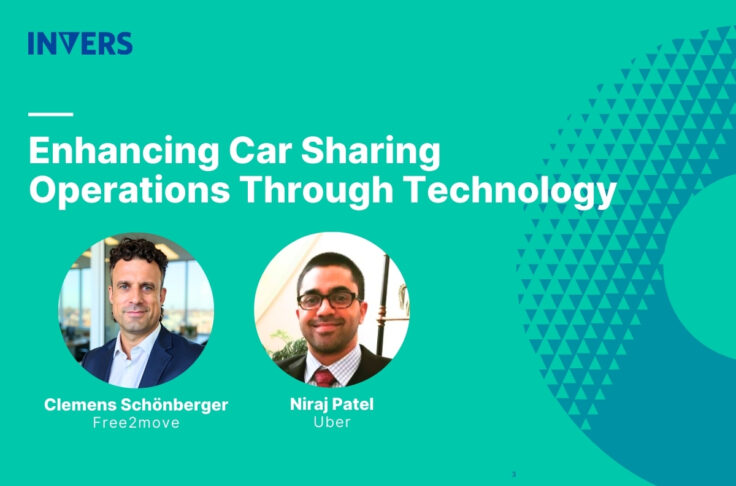Software for Shared Mobility: Lessons from Wunder Mobility
Summary
Shared mobility operators need to be flexible to react to market trends, scale their fleets according to demand, and take advantage of new partnerships, business models, and revenue streams. We talked to Gunnar Froh, founder and CEO of Wunder Mobility, about how the right software for shared mobility can enable this flexibility, what trends he sees in the shared mobility space, and what advice he has for existing operators to succeed in the future.

How did Wunder Mobility initially come about and what do you do today?
We launched in 2014 as the first European ride-hailing service in Germany. At the time, we faced strong resistance from taxi lobbyists and municipalities, so we offered our service in extremely congested cities like Manila, Rio de Janeiro, and New Delhi. We changed our business model soon after – instead of facilitating rides, we now build technology to enable vehicle sharing. Specifically, we provide mobility operators with the software to launch, manage and scale shared vehicle fleets. Our clients are startups, enterprises, or cities operating kickscooters, mopeds, e-bikes, or cars in free-floating or virtual station-based models. A catalog of IoT-connected hardware that we build in partnership with leading manufacturers complements our solution. Today we empower some of the biggest sharing operators like felyx, emmy and GreenMobility and regional champions like Süwag2GO or eddy.
What sets Wunder Mobility apart from its competition?
We are the one-stop-shop for our clients’ shared mobility business. We not only provide the necessary software for shared mobility, but also the first-class hardware they need all from a single source. This saves the operators a huge amount of work. Moreover, we develop our solution entirely in Germany with experts from nearly 40 countries. We also contractually guarantee our customers 99.99% availability, so their users never miss a ride and operators never miss out on any revenue. What our customers particularly value is the personal support from our Business and Technical Account Management Team. They are committed to helping our customers become even better and help them to use our features to optimize their daily operations and serve their users in the best way possible.
Additionally, we are fully capable of supporting operators like Avocargo who are diversifying their revenue streams while they team up with partners, and can also fully cover a B2B use case.
What are critical success factors in an operator’s tech stack and why?
The most important success factor of any operator’s tech stack is its reliability. Operators need all their business processes to be logically mapped, and trust that their users can actually rent their vehicles. In the worst case scenario, a failure of the software can mean that clients can no longer book shared vehicles for a time. This will lead to a loss of revenue and possibly enough frustration for the users to switch to other mobility providers.
Second, the scalability of the software is critical to support growth or synch with the seasonality of the service and reduce operations when needed. It also helps to react with flexibility in times of uncertainty.
Operators often don’t pay enough attention to the fact that back-end processes need to run smoothly. For example, the billing and payment infrastructure must follow business processes to handle non-payment disputes. It also needs to handle payment statuses appropriately to accurately report and understand revenue. While these processes must be functionally sound, operators must also be aware of local regulations: meeting direct debit notification and invoicing requirements, ensuring that items and prices are clearly stated after payment, and that they comply with 3D security requirements such as the PSD2 directive, so that the operator is in compliance with EU law when processing online payments.
And last but not least, the software for shared mobility needs to be constantly improved based on the market requirements.
What does a Wunder Mobility tech solution for operators look like? How is it set up?
Our software solution comprises a backend management system, a white-label mobile app and, depending on the client’s needs, our sharing-ready vehicles. The backend management system is the backbone for any mobility service. Providers use it to monitor and manage the entire operational side of the business. For example, the mobility operator can define different areas of operations, view and change the status of the vehicles in the fleet, navigate between customer data and trip details, assign tasks to the operations team, or create and optimize the various pricing models. The possibilities are very diverse.
Of course, all this happens behind the scenes and the end users do not see any of it. They only see the branded app in the App Store, which enables them to locate the vehicles via smartphone, to open and start them, and to lock them again after they finish their trip. However, we also have clients who prefer to develop the mobile app themselves. That’s not a problem since we also enable seamless connectivity.
What do you think is the potential of shared mobility?
For many people around the world, private transport has always been the preferred means of mobility. This is still true today, even if the pandemic has accelerated the adoption and use of shared mobility services in cities. At the same time, this is where the high potential for shared mobility comes from.
Let’s take Berlin as an example: people there take an average of 3.7 trips per day. Given Berlin’s population of around 3.6 million, this results in over 13 million trips per day. Berlin has over 50,000 shared mobility vehicles, and each one is used about 5 times per day on average. This brings us to 250,000 shared vehicle trips daily, less than 2% of all trips in the city. So the vast majority of people are not yet using shared mobility alternatives, and the challenge is to convince them of the benefits. In addition, in the course of urbanization and especially in view of their climate protection goals, cities will feel pressure to act in order to make mobility future-proof and climate-friendly. Shared mobility is certainly a good answer here.
In general, what do you see in terms of trends in the shared mobility space?
We are seeing many micromobility operators expand their existing by-the-minute rental offerings. At the same time, shared mobility services are offering additional medium- to long-term subscription options, ranging from daily to weekly to monthly rentals. The different rental models aren’t mutually exclusive, but offer a far greater degree of flexibility to the end-user. The variety lets users choose exactly the right type of vehicle and rental mode to meet their needs.
It’s also exciting to see that some mobility providers diversify their revenue streams. Our client Avocargo, a shared electric cargo bikes operator based in Berlin, is a good example. They work with local partners to offer free ride minutes. This gives current clients greater incentives to ride, and helps mobility operators attract new users from their partners’ client base.
We’re also seeing micromobility operators start to use aggregators’ platforms that offer an overview of all the transportation options available in an area. This helps operators generate additional demand for their services, and increase the utilization of their fleets.
For existing operators to succeed in the years to come, what would be your best advice for them?
Shared mobility is still in competition with private car ownership, which promises a very high level of comfort and availability. It’s therefore essential for operators to offer their clients an appealing user experience. This starts with a user-friendly app and seamless sign-up, rental, and payment processes – all based on a suitable software for shared mobility. It continues with attractive pricing and functional, safe, and clean vehicles. In addition, customers expect quick accessibility and want a vehicle to meet their needs nearby at all times. This leads to a fundamental challenge for operators. How can they manage their fleets in the most efficient and effective way?
The key will be for operators to make decisions based on data. What is the best distribution of vehicles within a business area? How should they time repair and charging cycles? And when does it make sense to contact the user through an email or push notification?
However, all this is secondary if operators fail to manage their fleet profitably. Cost sensitivity will therefore continue because every euro or dollar saved is an euro or dollar earned.


